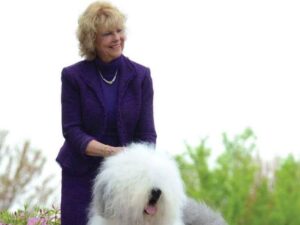
Jere Marder | Lambluv Old English Sheepdogs
Jere Marder, Breeder of Lambluv Old English Sheepdog for 40+ years. Insights on the breed and show community challenges.

Home » Dog Breeds » Old English Sheepdog Dog Breed
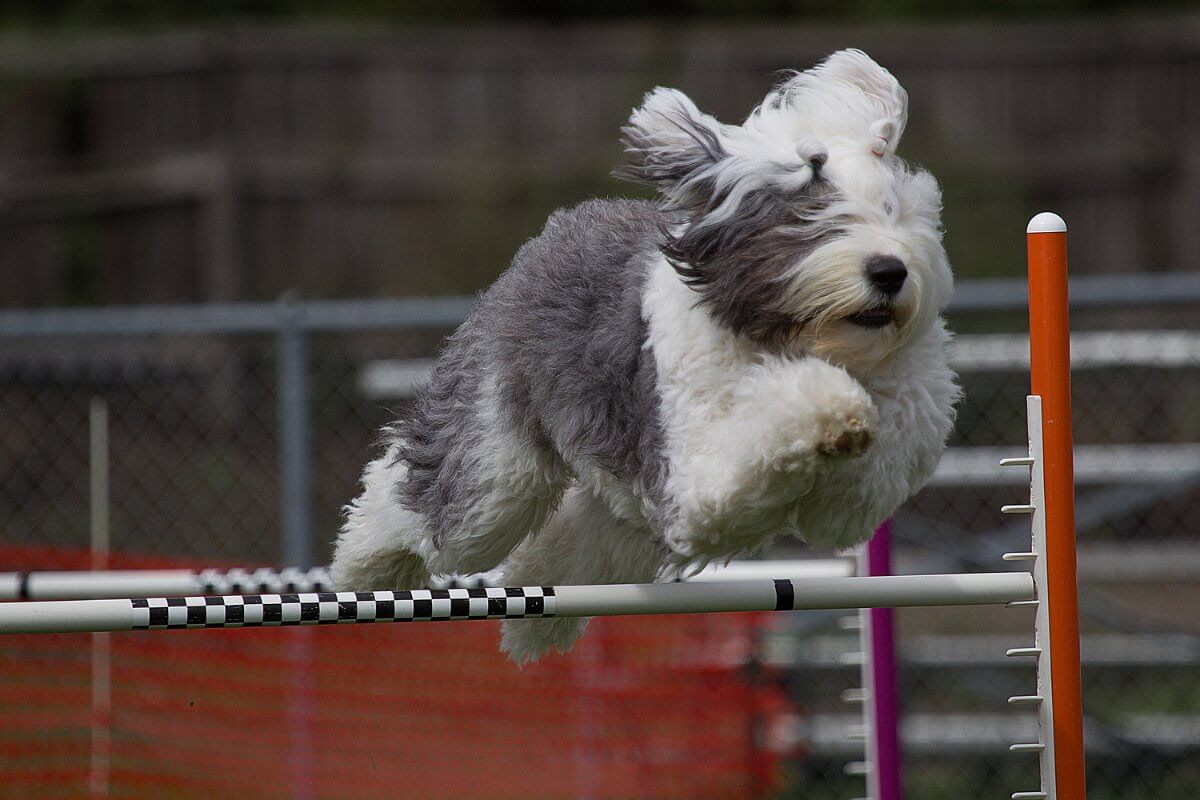
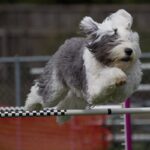
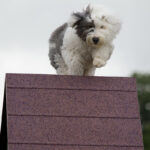
The Old English Sheepdog, also known as the Bobtail, is an adaptable and intelligent dog with a clownish personality and its own signature style. A watchful and courageous dog, the OES is a sturdy and athletic companion that is easily recognized by its distinctively shaggy coat. Historically, the breed assisted farmers with transporting cattle and sheep to market, and this work produced a dog that moves with an easy-going amble and an elastic gallop. Today, this sweet and sometimes silly dog enjoys being active at home and can be a fine competitor in Conformation, Obedience, Agility, and Herding competitions.
Herding
21 – 22 inches
60 – 90 pounds
10 – 12 years
| Country of Origin | England |
|---|---|
| Bred For | Herding & Droving, Companionship |
| Known For | Shaggy Coat, Gentleness, Loud Bark |
| Popularity | Moderate |
| Temperament | Adaptable, Even, Intelligent |
| Activities | Herding, Running, Hiking, Conformation Shows, Dog Sports |
The Old English Sheepdog has one of the most enigmatic of all canine origin stories. There is evidence that the breed originated in the southwestern counties of England in the early nineteenth century, though it may have descended from the Bearded Collie, the Russian Owtchar, or another dog entirely.
Writings during the time of the breed’s supposed origins reported a dog used to drive cattle and lambs to market. Owners docked their dogs’ tails to indicate they were drovers’ dogs and to offer protection from the sharp hooves of the much larger stock animals. As a result, the dogs were often dubbed the “Bob” or “Bobtail.”
When the Old English Sheepdog first arrived in the United States in the late 1880s, it was welcomed by a Pittsburgh manufacturer by the name of W. Wade. By the 1900s, just five affluent American families owned, showed, and bred the OES. One show administrator advised judges at the 1904 Westminster Show in New York to “take plenty of time; the dogs in the ring are the property of some of our leading Americans.”
In 1885, the American Kennel Club officially recognized the Old English Sheepdog. Henry Arthur Tilley founded the Old English Sheepdog Club of America in 1904. Tilley and his brother, William Steeds Tilley, were instrumental in the development of the Breed Standard that is used today by breeders and judges. Many of the dogs they bred can still be found in the extended pedigrees of today’s OES.
A mature male Old English Sheepdog typically stands 22 inches or more at the shoulder, while females usually measure around 21 inches tall.
Male Old English Sheepdogs typically weigh between 70 and 90 pounds, with females slightly lighter at 60 to 80 pounds.
The Old English Sheepdog is a well-balanced and sturdy dog, built for herding livestock and driving the animals to market. The breed has a strong, substantial bone structure that supports its well-muscled and solid frame. In terms of proportion, the breed’s body length is approximately the same as its height, displaying a compact and practically square silhouette.
Texture: The Old English Sheepdog has an unmistakable double coat, with outer guard hairs that are rough in texture and an undercoat that’s dense and waterproof. On the head, the hair is profuse, completely covering the eyes, but the hair on the ears is more moderately long and dense. The body is covered in a long, thick jacket, longer still over the hindquarters, and the legs are well-coated all-around. The hair has a harsh texture; not straight, but rather shaggy and without curl.
| Standard Color | |
|---|---|
| Black & White | ee |
| Fawn & White | ee |
| Brown & White | ee |
| Blue Merle | ee |
| Blue | ee |
| Grizzle | ee |
| Gray | ee |
| White | ee |
| Blue Gray | ee |
| Grizzle & White | ee |
| Blue & White | ee |
| Blue Gray & White | ee |
| Blue Merle & White | ee |
| Gray & White | ee |
| Grizzle & White | ee |
A Note About Color: Old English Sheepdog Puppies are born black and white without an undercoat. As they mature, the coat becomes hard in texture and lighter in color. A brown tinge may be apparent during the transition, but any brown (or black) in an adult coat is unacceptable.
Often referred to as the “Bobtail,” the Old English Sheepdog has traditionally had its tail closely docked. The purpose of tail docking was to prevent injury while the dog worked as a herder and drover of livestock, and to avoid taxes levied on dogs that did not work. The natural tail of an OES is bushy in appearance and is typically carried below the level of the back. It is often described as plume-like and gives the dog a distinctive, if nontraditional, appearance.
The Old English Sheepdog is known for its shaggy coat, sturdy frame, and adaptable disposition. These dogs are typically fun-loving and playful, but they can also be great guardians and protectors of the family. The breed’s signature coat, though beautiful, requires a serious commitment to keep it looking its best. The good news is that, while being large dogs, the typical OES can adapt well to suburban life as long its exercise needs are met.
The Old English Sheepdog is generally a healthy and robust breed, but like all dogs, individuals can be susceptible to certain issues. Regular veterinary care, a healthy diet, and adequate exercise can help to minimize the risk of any health concern.
The average lifespan of the Old English Sheepdog is 10 to 12 years. Responsible breeders health-test their breeding stock to increase the likelihood that their dogs will enjoy long and healthy lives.
Although generally a healthy breed, some OES can be prone to certain health conditions, including:
The Old English Sheepdog is widely known for its friendly and affectionate nature. These dogs have a gentle and loving disposition that endears them to people of all ages. Their welcoming demeanor and warm personality make them an excellent choice as a companion. These playful dogs often display remarkable patience and tolerance, making them an ideal choice for families seeking a canine companion that can coexist harmoniously with children.
One of the standout qualities of the Old English is the breed’s playful spirit. These dogs retain a youthful exuberance well into adulthood, which means they can engage in playtime with children or enjoy an active lifestyle on the farm. Their boundless enthusiasm for games and outdoor activities encourages family members to stay active and engaged with their pets.
The breed’s intelligence is another distinguishing trait. Old English Sheepdogs are quick learners and have a knack for understanding and responding to direction. This makes them responsive to training, although they can display an independent streak at times. Patience and consistency are the keys to unlocking their full potential.
While their intelligence is evident, the OES is also humorous and its sometimes mischievous side should not be overlooked. Playful antics are typical of the breed and can bring a smile to the faces of those fortunate enough to share their lives with these dogs. Their shaggy appearance, including the distinctive beard and mustache, and expressive eyes only add to the dog’s comical charms.
The Old English Sheepdog’s herding heritage is still evident today. These dogs can readily exhibit their inclination to gather the flock by gently nipping at the heels of their family members, a carryover from their historical role as a livestock herder. These tendencies, though inappropriate at times, can be managed with proper training and redirection.
The Old English Sheepdog is a large breed with a large appetite. To support this dog’s overall health and maintain its impressive physique, it’s crucial to provide a well-balanced and high-quality diet throughout its lifetime.
Selecting the right type of dog food is the first step in ensuring a Sheepdog receives the necessary nutrition it needs. Protein is essential for muscle maintenance and overall health and moderate levels of fat are needed to provide a dependable energy source.
Carbohydrates provide energy too, and they also contribute the fiber that is important for digestive health. Feeding a diet that includes healthy carbohydrates, such as brown rice, sweet potatoes, or whole grains, is crucial.
The average adult Old English Sheepdog needs from 2.5 to 3.5 cups of high-quality food a day. Still, portion control is a key aspect of good nutrition. The breed’s large size can make these dogs prone to obesity if overfed. It is important to adjust portion sizes as needed based on the dog’s age, activity level, and body condition. Healthy weight is essential to prevent a range of health issues and diseases.
Training the Old English Sheepdog should start as early as possible. Puppies are like sponges and can quickly learn and adapt to new commands and routines. Socialization should also begin during the puppy stage to ensure the youngster becomes well-adjusted around people and other animals, and in a variety of environments.
Sheepdogs are well-known for their intelligence and eager-to-please nature. This combination makes them highly trainable and a pleasure to work with. However, their independent streak can appear as occasional stubbornness and present some interesting challenges.
Consistency in training is essential, as is establishing clear rules and boundaries. It is important for all members of the family to interact with the OES consistently. This helps to prevent confusion and it reinforces the desired behaviors. Basic obedience training is a must, and leash training and recall training are important for dogs that spend time in public settings.
The Old English Sheepdog can be sensitive, so patience is crucial. Avoiding harsh training methods and punishment is essential, as these can damage the dog’s trust and its willingness to learn. Instead, using positive reinforcement techniques, such as treats, praise, and toys, is advisable.
Exercise is a fundamental component of caring for an Old English Sheepdog. These lovable, shaggy dogs have boundless energy and require regular physical activity to maintain their overall health and happiness.
| Energy Level | Moderate |
|---|---|
| Exercise Requirements | 2 Hours/Day (Minimum), Daily Walks, Vigorous Running, Regular Exercise, Playing with Another Dog, Mental Stimulation |
The Old English Sheepdog is a large and active breed known for its agility and strength. These dogs have a history of herding and working long hours, and this legacy has left a mark on their exercise needs. Providing them with at least two hours of exercise each day is crucial for their well-being.
Exercise is essential for maintaining the physical fitness of an OES. These dogs require regular activity to keep their muscles toned and their joints healthy. Exercise helps to prevent obesity and other health-related issues common in many dogs today. Anything from walking and running to participating in a Herding or Agility Trial can be a great way for the dog to remain healthy and fit.
In addition to physical exercise, Sheepdogs need plenty of mental stimulation each day. These intelligent dogs thrive on activities that challenge their minds, so interactive games, puzzles, and obedience training can provide the kind of mental exercise that prevents boredom and destructive behaviors.
Due to the breed’s thick coat, exercising in hot weather can be challenging for the Old English Sheepdog. Providing plenty of fresh water and offering shorter walks are recommended whenever it is hot outside. Otherwise, when temperatures drop, the OES is generally well protected for the cold weather.
The Old English Sheepdog is renowned for its iconic shaggy look, but the breed’s signature coat requires regular attention. These happy herding dogs are heavy shedders, so grooming can be challenging.
| Coat Type | Profuse, Shaggy, Hard Texture |
|---|---|
| Grooming Requirements | Daily Brushing, Occasional Bathing, Routine Ear Cleaning, Periodic Nail Trimming, Regular Tooth Brushing |
Brushing is a fundamental aspect of caring for the Old English Sheepdog. The breed’s double coat consists of a soft, insulating undercoat and a longer, coarse outer coat. Regular brushing is essential to prevent matting and tangling. It should be done daily, if possible, or at least three times a week.
Bathing an OES should be done as needed, typically every 6-8 weeks or when the dog gets especially dirty. Because the coat is dense, it’s important to make sure the dog is completely dry after a bath to avoid any skin issues from developing.
Because the Sheepdog’s eyes are partially obscured by the hair, it’s important to ensure the eyes are kept clean and free from discharge. Trimming the hair around the eyes is advisable.
At least once a month, the nails of the OES should be trimmed, and the hair between the paws should be trimmed as well. Additionally, the ears should be checked weekly for signs of dirt, redness, or a strong odor that requires immediate attention to prevent infection.
Living with an Old English Sheepdog is a delightful adventure filled with love, laughter, and a healthy dose of playful antics. The breed’s iconic appearance, affectionate disposition, and intelligence make these dogs wonderful additions to families that are willing to invest in the dog’s care. OES return the favor by offering companionship, security, and a distinctive charm that’s hard to ignore.
The breed’s appearance is instantly recognizable, with its profuse, shaggy, coat and intelligent expression. The distinctive appearance of the OES often draws attention and elicits compliments from admirers. However, this gorgeous appearance needs regular attention and maintenance, so grooming is a challenge that needs to be considered.
The Old English Sheepdog thrives on human interaction and is known for forming deep emotional bonds with family members. The loving nature of this breed can make them an excellent choice as a canine companion. Despite their size, OES exude playfulness instead of intimidation, and they maintain their youthful exuberance and vitality well into adulthood.
The breed is known for its loyalty. These dogs are natural watchdogs, alerting their families to any unusual sounds or strangers. Typically sociable and friendly, with both friends and other pets, they often welcome invited guests warmly. This can make the their presence an asset at social gatherings and family events.
The Old English Sheepdog’s shaggy coat is well-suited for colder climates, but it can make the breed prone to overheating in hot weather. Adaptability to different climates can be achieved with appropriate grooming, providing shade and water in hot weather, and ensuring the coat is properly maintained year-round. While these dogs do well in larger homes with access to a yard where they can exercise and play, many can adapt to apartment living as long as their exercise needs are met.
Old English Sheepdog puppies are incredibly cute and appealing. However, when bringing one home, it’s essential to be well-prepared for the responsibilities, as well as the joys, that come with raising a puppy of this breed.
Caring for an Old English Sheepdog puppy is a delightful but demanding responsibility that requires dedication, patience, and a lot of love. This adorable, shaggy pup will quickly become a cherished family member, but it also has specific needs.
Early socialization is crucial for the Old English pup. Exposure to a variety of people, animals, and environments will all but ensure it grows up to become a well-adjusted and confident adult. Positive social experiences during the formative months can also help to prevent unwanted behaviors in the future.
The Old English puppy is widely known for its playful and energetic nature, requiring ample activity each day to burn off its boundless energy. Regular playtime, short walks, and interactive games are important as both physical and mental exercises.
During puppyhood, the OES often chews to alleviate the soreness that accompanies teething. Since chewing is a natural behavior that helps to soothe the discomfort, it’s important to provide safe and appropriate chew toys to prevent chewing on furniture, shoes, and other household objects.
Regular veterinary check-ups are crucial for the Old English Sheepdog puppy. Vaccinations, deworming, and regular wellness exams will provide protection from many common puppy illnesses. Regularly scheduled veterinary exams can also provide useful information on providing preventive care throughout the dog’s life.
Old English Sheepdogs are intelligent and active dogs that thrive on mental and physical stimulation. Engaging in various dog sports can provide both exercise and mental enrichment. Here are just a few activities that can be fun for an OES:
The Old English Sheepdog is recognized by the world’s leading registries and kennel organizations, which categorize the breed into a specific Group based on its unique characteristics. This breed is recognized worldwide under the following Group designations:
| Organization | Group Designation |
|---|---|
| AKC (American Kennel Club) | Herding |
| UKC (United Kennel Club) | Herding Dog |
| CKC (Canadian Kennel Club) | Herding |
| ANKC (Australian National Kennel Council) | Working Dogs |
| RKC (The Royal Kennel Club) | Pastoral |
| FCI (Fédération Cynologique Internationale) | Group 1: Sheepdogs and Cattledogs; Section 1: Sheepdogs |
The ideal Old English Sheepdog is described by a Breed Standard that is approved by each of the world’s leading registries and kennel organizations. The Breed Standards for this breed may be found in the following links:
| Organization | Breed Standard |
|---|---|
| American Kennel Club | AKC Old English Sheepdog Breed Standard |
| United Kennel Club | UKC Old English Sheepdog Breed Standard |
| Canadian Kennel Club | CKC Old English Sheepdog Breed Standard |
| Australian National Kennel Council | ANKC Old English Sheepdog Breed Standard |
| The Royal Kennel Club | RKC Old English Sheepdog Breed Standard |
| Fédération Cynologique Internationale | FCI Old English Sheepdog Breed Standard |
Old English Sheepdog clubs are indispensable in upholding the breed’s written Standard, promoting responsible breeding practices, and fostering a community for enthusiasts and breeders alike. These organizations often serve as hubs for education, dog shows and dog sports, and advocacy for the OES as a unique breed.
The Old English Sheepdog Club of America (OESCA) is the official breed club recognized by the American Kennel Club (AKC) in the United States. Its members offer a variety of resources for breed enthusiasts, including information on the Breed Standard, health statistics, and social events. The club also hosts an annual National Specialty show and other activities throughout the year.
Many regions and states also have local clubs that support the breed. These organizations often organize their own events, gatherings, and activities for breed supporters in their geographic area. The Old English Sheepdog Club of Greater Seattle and the Old English Sheepdog Club of Southern California are two examples of regional clubs that provide services for members in their community.
When purchased without sufficient understanding of this unique breed, an Old English Sheepdog can end up in need of fostering and rehoming.
The Old English Sheepdog Club of America (OESCA) has a rescue committee that assists in placing any OES that is in need anywhere in the United States. The committee members work with regional coordinators to facilitate rescue efforts.
Old English Sheepdogs are known for their profuse, shaggy coats, and they do shed. They require regular grooming to prevent matting and to manage the shedding hair. During seasonal changes, they tend to shed more heavily, requiring extra attention be paid to the loss of their thick undercoat.
Despite their thick coats, OES are not considered hypoallergenic. These dogs produce dander and shed their coats seasonally, which can trigger allergic reactions in sensitive individuals. Regular grooming can help to reduce the amount of hair and dander in the house, but it may not be sufficient for those with severe allergies.
Many Old English are born with tails, but it has long been the practice to dock tails before the newborns’ nervous systems are fully developed. Tail docking is done for both historical reasons and to comply with the Breed Standard, although it has become less common and even illegal in some countries. If a Sheepdog’s tail is not docked, it is long and heavily coated.
Old English Sheepdogs are rather large dogs, typically weighing between 60 and 100 pounds, with some individuals even exceeding this range. Males generally stand at 22 inches tall at the shoulder, showcasing their impressive silhouette, while females are slightly smaller, standing at 21 inches or more.
OES have a lifespan of around 10-12 years, which is typical for a dog of their size. Proper care, a balanced diet, regular veterinary checkups, and a healthy lifestyle can contribute to a longer, healthier life.
Old English are not typically aggressive. They are known to be playful, affectionate, and good-natured. However, like any dog, they require proper socialization and training to ensure they are well-behaved and comfortable around different people and situations.
Yes, Old English Sheepdogs have a double coat, consisting of a dense, soft undercoat and a long, coarse outer coat. Their double coat provides insulation and protection, but it also requires regular grooming to prevent matting and to manage shedding.
Old English are intelligent dogs and generally eager to please, making them highly trainable. However, they can be stubborn at times, so consistent, positive reinforcement training methods work best. Early socialization and obedience training are essential to bring out the best in this breed.
Yes, OES are known to be excellent family pets. They are affectionate and playful, and typically get along well with children. Their gentle and protective nature makes them a great addition to families, although their size and energy level should be considered.
Old English Sheepdogs can be good watchdogs due to their somewhat protective nature. They are vigilant dogs and may bark to alert their owners of anything unusual. However, they are generally not aggressive and should be trained to respond appropriately to different situations.
Old English can get along well with cats, especially if they are raised together and properly introduced. The breed’s herding instincts may come into play in a multi-animal household, but with training and socialization they can learn to coexist peacefully with feline family members.
OES are known for their watchful nature, especially when it comes to their family. They are loyal dogs and will always look out for their loved ones. Proper training is important to ensure their protective instincts do not lead to overly territorial behavior.
Old English Sheepdogs are not as common as other similar breeds, but they are not considered rare. Thankfully, these lovable companions have a dedicated following of enthusiasts and breeders in the US and around the world. However, their popularity has declined in recent years, partly due to their grooming requirements.
OES are intelligent dogs with a problem-solving nature. They respond well to training but may display an independent streak. Providing mental stimulation and engaging activities can help to keep their minds sharp.
Old English Sheepdogs have a deep, distinctive bark and they can be quite vocal. They may freely (and loudly) bark to alert their owners to something unusual or when they are bored. Training, and ensuring they have enough physical and mental stimulation, can help to manage any excessive barking.

Jere Marder, Breeder of Lambluv Old English Sheepdog for 40+ years. Insights on the breed and show community challenges.
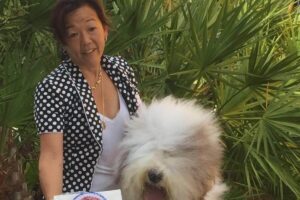
Interview with Liz Fujikawa, breeder of Old English Sheepdogs and Norwich Terriers. Insights on breed, health, and the dog show community.
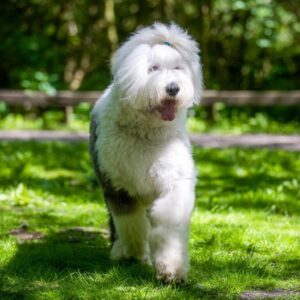
Many judges often wait to add the Old English Sheepdog dog breed to their credentials after they have had more judging experience. The coat
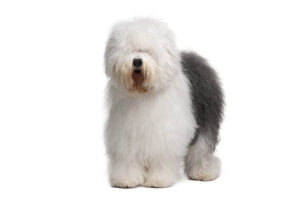
Interview with Herding Group Breeder Dianne McKee-Rowland – I live in Salem, Oregon. Having a mother who showed her Peke and always had one
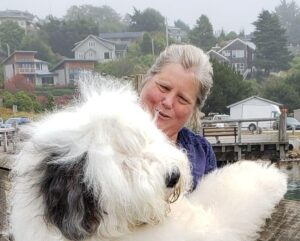
Interview with Herding Group Breeder Lita Long – We live in Oregon. (All of my life for 64 years.) While I was involved with my mother who
The best way to ensure a long and happy relationship with a purebred dog is to purchase one from a responsible breeder. Not sure where to begin?
Contact the National Parent Club’s Breeder Referral Program, which is listed on the AKC Breeder Referral Contacts page.
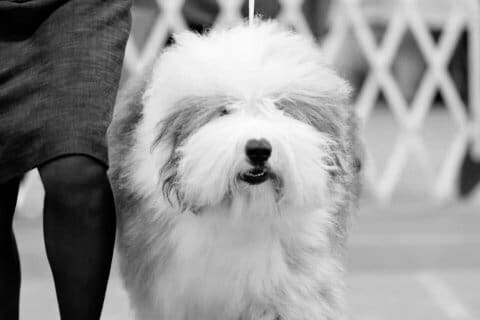

"*" indicates required fields
Showsight Magazine–the world’s most influential purebred dog publication since 1992. Each issue reaches a global audience dedicated to preserving the history and health of purpose bred dogs. Filled with award-winning editorial focused on news and insights from the dog show community, top breeders, handlers, AKC Judges, and more!